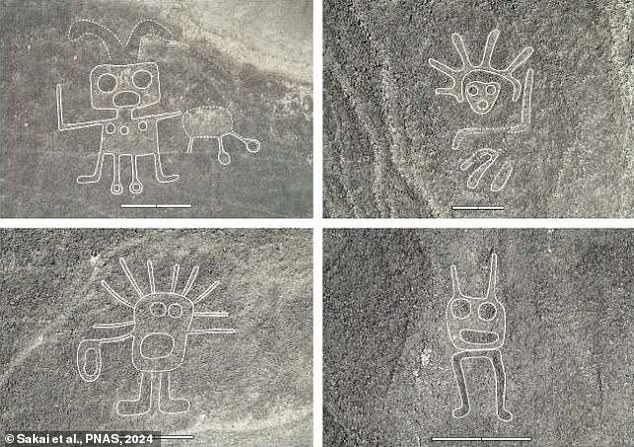For nearly 100 years, scientists have puzzled over the famous Nazca geoglyphs: ancient patterns on the floor of the Nazca Desert in southern Peru.
Now, with the help of AI, researchers have discovered another 303 drawings, possibly the strangest yet.
Among them are figures that look like aliens, orcas holding knives, cats, camels and a figure that looks like Pixar’s Wall-E robot.
The photographs show some of the new discoveries, with lines manually added to the images to emphasize the original lines, which have faded due to erosion.
The mysterious Nazca glyphs may date back to 400 BC, but scientists are still unsure of what, if any, their exact purpose was.
More than 300 mysterious Nazca glyphs discovered in Peru, including a Wall-E-like person (top left) and alien-like figures

The true purpose of the mysterious Nazca Lines has long puzzled archaeologists. Pictured: killer whales holding knives
The 303 new discoveries have been detailed by a group of researchers from Yamagata University in Japan and IBM’s Thomas J Watson Research Center in New York in the Proceedings of the National Academy of Sciences.
“It took almost a century to discover a total of 430 Nazca figurative geoglyphs, which offer important information about the ancient cultures of the Nazca Pampa,” the team states in its paper.
‘Here, we report on the deployment of an AI system across the Nazca region, a UNESCO World Heritage Site, leading to the discovery of 303 new figurative geoglyphs in just six months of field study.’
Researchers scanned aerial images of the Peruvian site with IBM artificial intelligence because it can identify markings on the landscape that the human eye would otherwise miss.
Of the 303 newly discovered geoglyphs, 178 were individually suggested by the AI, which had been trained to look for them in drone photographs.
They predominantly depict wild animals, such as orcas and domestic camels, and human-related motifs, including extraterrestrial-looking humanoids.
There are also what appear to be pairs of primates playing together, including a pair with large tails holding balls and a feline with a surprised expression.
Many are simply unclassifiable, but appear to show various distorted forms of the human figure, including a head with spiky hair and another head on a pair of legs.

They predominantly depict wild animals and human-related motifs, including humanoids and domesticated camels.

Many are simply unclassifiable, but appear to show various distorted forms of the human figure, including a head with spiky hair and another head on a pair of legs.

The Nazca Lines are a group of geoglyphs – large motifs carved into the ground – located in the Nazca Desert in southern Peru.
However, the true purpose of the mysterious Nazca Lines has long puzzled archaeologists.
Some believe that its purpose was to act as a kind of observatory, to mark the places where the sun and other celestial bodies rose or set at the solstices.
Other theories suggest that they were created to be seen by the gods in the sky, but they may also have simply been artistic expressions much like those we see today.
Often a geoglyph is too large to be appreciated at ground level, so only when one is high enough in the air can one discern the shapes of some of the designs.
For this reason, the intricacies of many of the designs were not fully understood until airplanes were invented and the works of art were seen from the sky.

The published photographs show some of the new discoveries, with lines manually added to the images to emphasize the original lines, which have faded due to erosion.

Pictured: A Homer Simpson-style Nazca human geoglyph previously found by researchers.

Geoglyph of a spider in Nazca. The figure is said to be 45 meters long and is made up of a continuous line.
The Nazca Lines were apparently first seen in 1939 when a pilot flew over the Nazca Lines in the Peruvian coastal highlands, although they were likely seen by locals on the hilltops much earlier.
Contrary to popular belief that the figures can only be seen from the air, many of them are also visible from the surrounding hills.
According to experts, IBM’s artificial intelligence could make it possible to discover even more geoglyphs, possibly thousands.
“AI may be on the cusp of ushering in a revolution in archaeological discovery similar to the revolution aerial imaging has had in this field,” they say in their paper.


